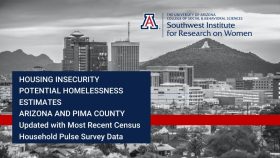
The University of Arizona Southwest Institute for Research on Women has released its most recent update to its report on Housing Insecurity Indicators and Potential Homelessness Estimates for Arizona and Pima County. This report measures current housing insecurity with newer census data.
Since the last census wave, there are points of significant concern.
- Despite hardship caused by inflation, the positive macroeconomic situation has continued to hold steadily at the national and state levels (AZ unemployment has increased very modestly in recent months, but remains well below historical averages). In a previous survey wave, collected December 9th-19th 2022, the proportion of non-current renters was 8.9%. In the most recent survey, conducted January 4th–16th 2023, this proportion rose to 11.2%.
- In the December 2022 survey wave nearly a fifth of non-current renters (19%) reported viewing eviction in the next two months as “very likely”. The intensity of this indicator increased slightly in January with 21% of non-current renters viewing eviction as “very likely” in the next two months.
- In a previous report from mid-October, 81% of non-current renters had not applied for rental assistance, this proportion fell to 52% in the most recent wave. This suggests that more non-current renters are seeking out rental assistance, however it is unclear if rental assistance will reach these households. Mortgage holders in Arizona continue to be in a strong financial position. Only 3.7% reported being not current on mortgage payments (3.6% in the previous survey). Of those that are not current on payments 14% see a foreclosure in the next two months as “very likely”. This is a large increase relative to the <1% seeing foreclosure as very likely in the last survey wave, but this is a very small percentage of all mortgage holders so large swings are possible in these proportions and don’t necessarily indicate much (future surveys will reveal if this is a trend).
- Nationwide, individuals reporting that they have serious disabilities are increasingly disproportionately likely to report being behind on rent payments. It appears that members of historically marginalized groups (especially people living with disabilities) are not benefiting from the improved economy as quickly on average as other demographic groups. Counts of calls to 211 from Pima County indicate a substantial increase in calls related to housing and shelter, utilities, and food requests in the last 6-8 months. In January we observed the largest monthly count of eviction filings in Pima County since the onset of the pandemic. Last, figures from Maricopa’s HMIS data indicate a 10% increase in the total number of people experiencing homelessness in Maricopa County between January and December of 2022 (and a 20% increase in the “balance of the state”, the areas outside of Maricopa and Pima counties).
This stubbornly high level of housing insecurity among Arizona renters is unusual given historically low unemployment, and contrasts with continuing improvement in the financial position of Arizona mortgage holders. Rising rents and inflation are the likely the central drivers of this disconnect, especially for households with limitations on their ability to benefit from the strong labor market.
There is continuing good news to report on.
- Tucson rent prices have been decreasing, albeit very modestly, in recent months. This reversal of recent trends is a very welcome relief but does not erase the increases in average and median rents experienced over the past two years (which remain in the area of 30-33% even after including the small recent declines in median rents). Statewide 69% of Arizona renters reported an increase in their monthly rent in the last year and 57% reported an increase of $100 or more. This indicates that most renters have been directly impacted by increases in rent prices in Arizona over the past year. Disparities in financial strain along the lines of household incomes have increased in this and recent survey waves. Measures of households not being current on rental payments and those experiencing great difficulty meeting spending needs indicate that lower-income and BIPOC households in Arizona are slipping behind disproportionately.
